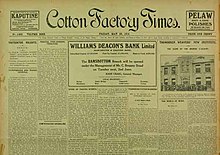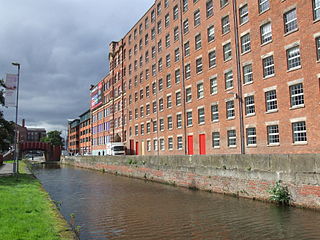
A cotton mill is a building that houses spinning or weaving machinery for the production of yarn or cloth from cotton, an important product during the Industrial Revolution in the development of the factory system.
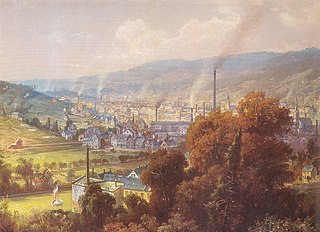
Textile manufacture during the British Industrial Revolution was centred in south Lancashire and the towns on both sides of the Pennines in the United Kingdom. The main drivers of the Industrial Revolution were textile manufacturing, iron founding, steam power, oil drilling, the discovery of electricity and its many industrial applications, the telegraph and many others. Railroads, steamboats, the telegraph and other innovations massively increased worker productivity and raised standards of living by greatly reducing time spent during travel, transportation and communications.

The Lancashire Cotton Famine, also known as the Cotton Famine or the Cotton Panic (1861–65), was a depression in the textile industry of North West England, brought about by overproduction in a time of contracting world markets. It coincided with the interruption of baled cotton imports caused by the American Civil War and speculators buying up new stock for storage in the shipping warehouses at the entrepôt. This, as well as causing cotton prices to rise in China, in which trade had been steadily increasing following the Second Opium War and during the ongoing Taiping Rebellion. The increase in cotton prices caused the textile trade to rapidly lose two-thirds of its previous value of exports to China from 1861-1862. The worldwide cotton famine also produced a boom in Cotton production in Egypt and Russian Turkestan.
The Miners' Federation of Great Britain (MFGB) was established after a meeting of local mining trade unions in Newport, Wales in 1888. The federation was formed to represent and co-ordinate the affairs of local and regional miners' unions in England, Scotland and Wales whose associations remained largely autonomous. At its peak, the federation represented nearly one million workers. It was reorganised into the National Union of Mineworkers in 1945.
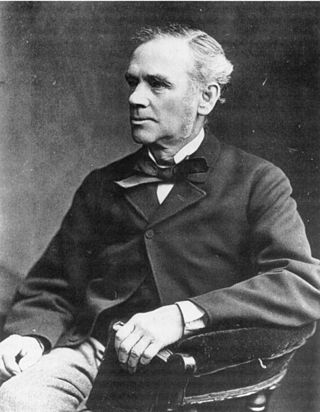
Hugh Mason was an English mill owner, social reformer and Liberal politician. He was born in Stalybridge and brought up in Stalybridge and Ashton-under-Lyne until he entered the family cotton business in 1838 after a seven-year period working in a bank. Having originally opposed trade unions, Mason became a paternalistic mill owner, creating a colony for his workers with associated facilities and ensuring that they experienced good conditions. During the Lancashire Cotton Famine of the 1860s he refused to cut workers' wages although it was common practice.
Bagley & Wright was a spinning, doubling and weaving company based in Oldham, Lancashire, England. The business, which was active from 1867 until 1924, 'caught the wave' of the cotton-boom that existed following the end of the American Civil War in 1865 and experienced rapid growth in the United Kingdom and abroad.

Greenfield Valley Heritage Park is a 70-acre (28 ha) country park in the United Kingdom. It is located in Greenfield, near the town of Holywell in North Wales. It is well known for its woodland, reservoirs, ancient monuments, rich industrial past and its factories which played a part in the Industrial Revolution.
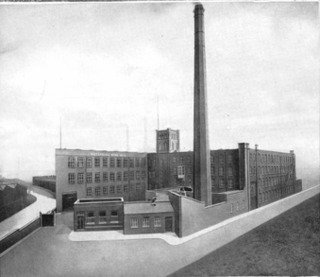
Waterside Mill, Ashton-under-Lyne was a combined cotton spinning weaving mill in Whitelands, Ashton-under-Lyne, Greater Manchester, England. It was built as two independent factories. The weaving sheds date from 1857; the four-storey spinning mill dates from 1863. The spinning was taken over by the Lancashire Cotton Corporation in the 1930s. Production finished in 1959. Waterside Mill was converted to electricity around 1911.
Palmer Mills were cotton spinning mills in Portwood, Stockport, Greater Manchester, England. Built in the late 19th century, they were taken over by the Lancashire Cotton Corporation in the 1930s and sold on. Renamed the Stockport Paper Mill, they survived into the 21st century when they were demolished to be replaced by modern businesses.
The Tameside Reporter is a locally based weekly newspaper which primarily serves the Metropolitan Borough of Tameside. It is one of very few remaining independently owned newspapers in the country and has existed since 1855. The group previously distributed a free weekly newspaper, called the Ashton Reporter in recognition of the group's origins, and continues to publish the Glossop Chronicle.
The Lancashire and Cheshire Miners' Federation (LCMF) was a trade union that operated on the Lancashire Coalfield in North West England from 1881 until it became the Lancashire area of the National Union of Mineworkers in 1945.
Mortimer Grimshaw was an English political activist, strike leader and cotton weaver. He briefly attained national fame in the 1850s due to his part in the Preston strike of 1853–54. A large man whose face was marked by smallpox, he was renowned for his oratory, which earned him the nickname of the "Thunderer of Lancashire".
Charles Allen Clarke (1863–1935), most widely known as C. Allen Clarke, was an English working-class humorist, novelist, journalist and social investigator from Lancashire. An Independent Labour Party (ILP) member and friend of Robert Blatchford, Clarke succeeded Joseph Burgess as editor of the Yorkshire Factory Times.
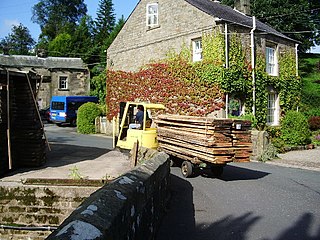
Kirk Mill is an early example of an Arkwright-type cotton mill and a grade II listed building in Chipping, Lancashire. Built in the 1780s on the site of a corn mill dating back to at least 1544, it operated as a cotton mill with water frames and then throstles until 1886 when it was sold and repurposed as H.J. Berry's chairmaking factory, powered by a 32 ft (9.8 m) waterwheel, which continued in use, generating electricity until the 1940s.
The Northern Counties Textile Trades Federation was a trade union federation in northern England.
The Blackburn and District Weavers' Winders' and Warpers' Association was a trade union representing cotton industry workers in Blackburn, Lancashire, in England. One of the earliest weavers' unions to endure, it formed a model that many others copied, and was at the centre of early attempts to form a regional federation of cotton trade unions.
The Lancashire Amalgamated Tape Sizers' Friendly Society was a trade union representing workers involved in the preparation of cotton in the Lancashire area of England.
The Ashton-under-Lyne and District Power Loom Weavers' Association was a trade union representing cotton weavers in the Ashton-under-Lyne area of Lancashire, in England.
The Hyde and District Weavers', Winders', Warpers' and Doublers' Association was a trade union representing workers in the cotton industry around Hyde, then in Cheshire and Derbyshire in England.
Peter Atherton was a British inventor, entrepreneur, and cotton mill proprietor. Renowned for his pioneering work as a designer and manufacturer of textile machinery during the early Industrial Revolution, Atherton began his career by assisting Richard Arkwright and John Kay in developing the ground-breaking spinning frame in the late 1760s. Subsequently, Atherton developed methods to elongate cotton, wool, and silk fibres, resulting in stronger, smoother yarn and finer quality fabrics, representing a notable progression in textile manufacturing. Atherton's influence extended to mill construction nationwide, where his innovative designs and use of steam power marked significant advancements in industrial architecture. He engaged with policymakers and advocated for the interests of the British textile industry, notably participating in a delegation that met with Prime Minister William Pitt the Younger in 1788 to safeguard domestic production against the encroachments of the East India Company. Additionally, Atherton established and invested in numerous enterprises within both the textile and clock and watchmaking industries. One of his companies, Atherton & Co., became a leading manufacturer of cotton spinners, with locations in Warrington, Manchester, and Liverpool.
